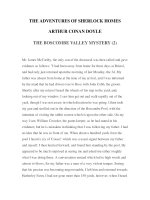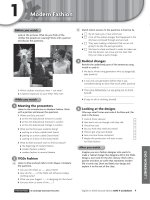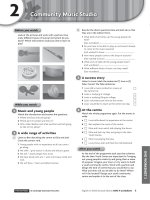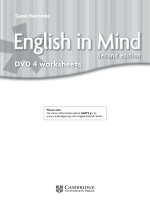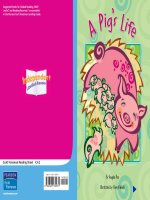EiMTV 4 2
Bạn đang xem bản rút gọn của tài liệu. Xem và tải ngay bản đầy đủ của tài liệu tại đây (333.75 KB, 2 trang )
2
Community Music Studio
Before you watch
Look at the pictures and work with a partner. How
many different types of musical instrument do you
know? Which instruments would you like to learn to
play?
b
Rewrite the direct questions Elsie and Josh ask so that
they are in the indirect form.
1 What kind of activities can the young people do
here?
Elsie wondered …………………………………………………………………………
2 Do you have to be able to play an instrument already
to come to the music sessions?
Josh wanted to know ………………………………………………………………
3 How many people come to the drop-in sessions?
Elsie wanted to know ………………………………………………………………
4 What sorts of skills do the young people learn?
Josh wondered ………………………………………………………………
5 What different kinds of music can they make?
Elsie wondered ………………………………………………………………
3 A success story
Listen to Louis. Mark the sentences (T) true or (F)
false. Correct the false sentences.
While you watch
1 Music and young people
Watch the introduction and answer the questions.
1 Where are Elsie and Josh going?
2 Which part of London are they in?
3 Who is Ben Skelton and what are Elsie and Josh going
to talk to him about?
2 A wide range of activities
a
Listen to Ben describing the centre to Elsie and Josh.
Circle the correct verb.
PHOTOCOPIABLE
© Cambridge University Press 2012
4 At the centre
Watch the whole programme again. Put the events in
order.
a
Louis talks about his experience at the centre.
b
Ben explains the work of the centre.
c
Elsie and Louis watch Josh playing the drums.
d
Elsie and Josh say they are going to the Ham
Youth Centre.
e
Elsie tries playing the bass.
f
Louis shows Josh and Elsie the midi keyboard.
After you watch
At the end of the programme Josh says that schemes
like the Ham Youth Centre are important for ‘bringing
out young people’s creativity and giving them a sense
of purpose.’ Imagine your town or city wants to build
a youth community centre. Work with a partner and
design the kind of centre that you would like to use.
What activities will you be able to do there? Where
will it be located? Design your youth community
centre and explain it to the rest of the class.
English in Mind Second edition DVD 4 worksheet
6
DVD WORKSHEET 2
1 Young people with no experience at all can come /
go along.
2 We offer / give tuition in drums and electric guitar.
3 We tell / teach people how to DJ.
4 We have bands who are / were into heavy metal and
rock.
5 We will have / have accredited courses.
1 Louis did a music production course at
the centre first.
2 Louis is studying at college.
3 Louis is studying DJing at college.
4 Louis volunteers part-time at the centre.
5 Louis would like to teach at the centre one day.
2
TEACHING NOTES
Community Music Studio
Programme overview
SUMMARY
In this programme the presenters visit The Ham Youth
Centre in southwest London, where young people
can do sport, arts, cooking and music. They talk to
club manager Ben Skelton about the community
music scheme and meet Louis, who attends the
centre. Louis talks about his experience at the centre
and shows Elsie and Josh the recording studio. The
presenters have a go at using the equipment.
LANGUAGE
This programme corresponds to Unit 11 of English in
Mind Second edition Level 4.
Grammar: Indirect questions
Verbs + wh-questions
Vocabulary: Qualifying comparisons
Listening to music
Before you watch
Students work in pairs to ask and answer the
questions. At the end of the task, ask a few pairs to
feedback.
While you watch
1 Music and young people
Watch Scene 1. Then put students in pairs to answer
the questions.
Answers 1 the Ham Youth Centre 2 southwest
3 the manager of the centre; the community music scheme
2 A wide range of activities
a
PHOTOCOPIABLE
© Cambridge University Press 2012
Ask students to rewrite the direct questions in the
indirect form. Students can work in pairs to complete
this task.
Answers
1 what kind of activities the young people could do
there.
2 if you had to be able to play an instrument already to
go to the music sessions.
3 how many people went to the drop-in sessions.
4 what sorts of skills the young people learned.
5 what different kinds of music they could make.
3 A success story
This task practises listening for specific detail. Scene
3 introduces Louis, who talks about his experience at
the centre. Ask students to listen to Louis and mark the
sentences true or false. To extend the task, ask students
to correct the false sentences.
Answers
1 F (he first did a DJ course, then he moved on to a
music production course) 2 T 3 F (he’s studying music
production) 4 T 5 F (he also teaches at the centre)
4 At the centre
Before starting this task, allow students time to read the
sentences. Then watch the whole programme again and
ask students to order the sentences.
Answers 1d 2b 3a 4e 5c 6f
After you watch
Tell students that their local town council wants to open
a new youth community centre and are inviting people to
submit proposals. Students should design a centre which
should offer young people the chance to learn how to
do new things. Encourage students to use qualifying
comparisons where possible in their discussion, e.g. It’s
far better to have a recording studio than a film studio;
It’s nowhere near as expensive as you’d think to have a
regular dance class. Ask students to show their proposals
to the class and explain them.
English in Mind Second edition DVD 4 worksheet
7
DVD Teaching Notes 2
Before starting this activity, you may want to preteach the meaning of twice-weekly and drop-in
session. Allow students time to read the sentences.
Watch Scene 2 and ask students to circle the correct
verbs.
Answers 1 come 2 offer 3 teach 4 are 5 have
b

